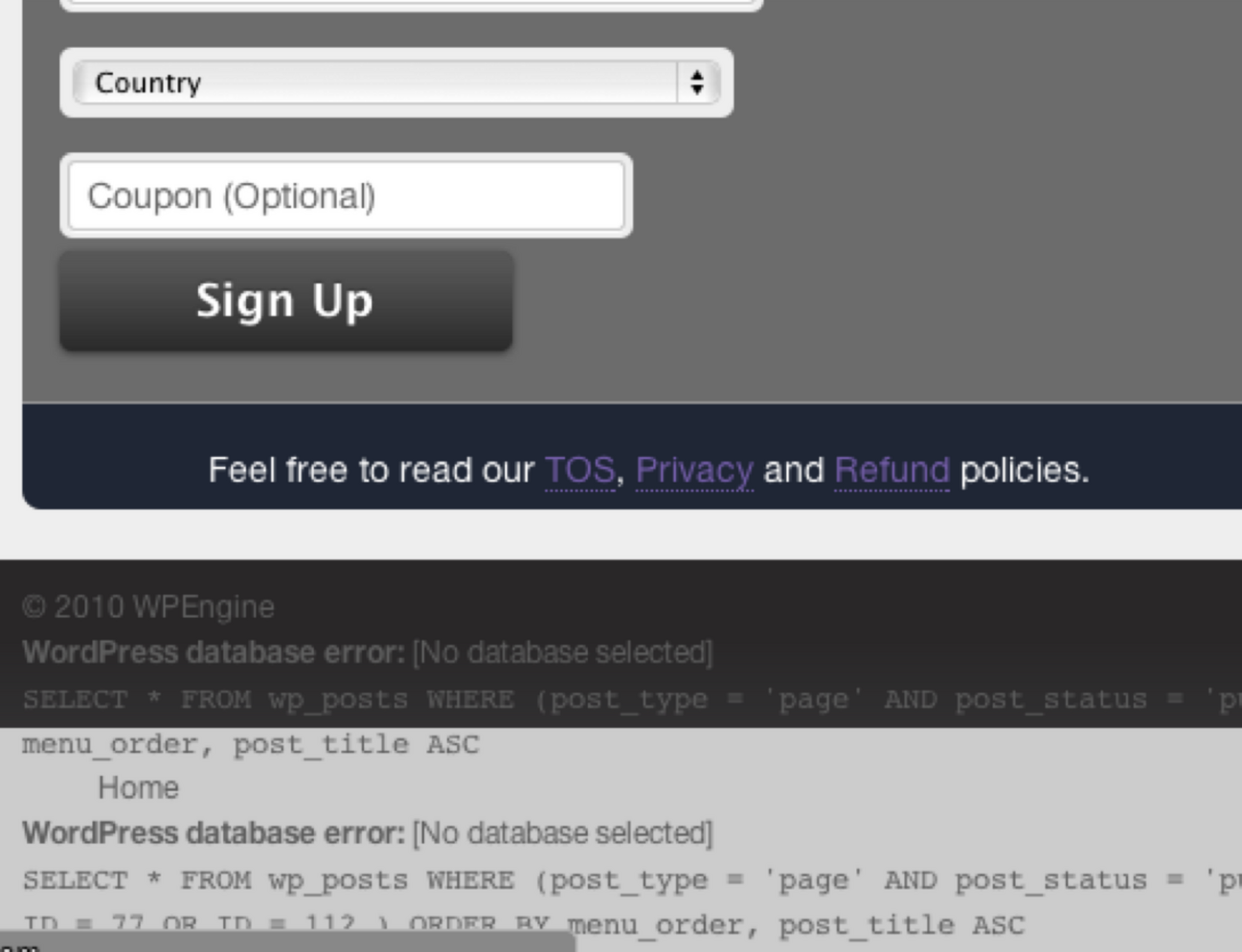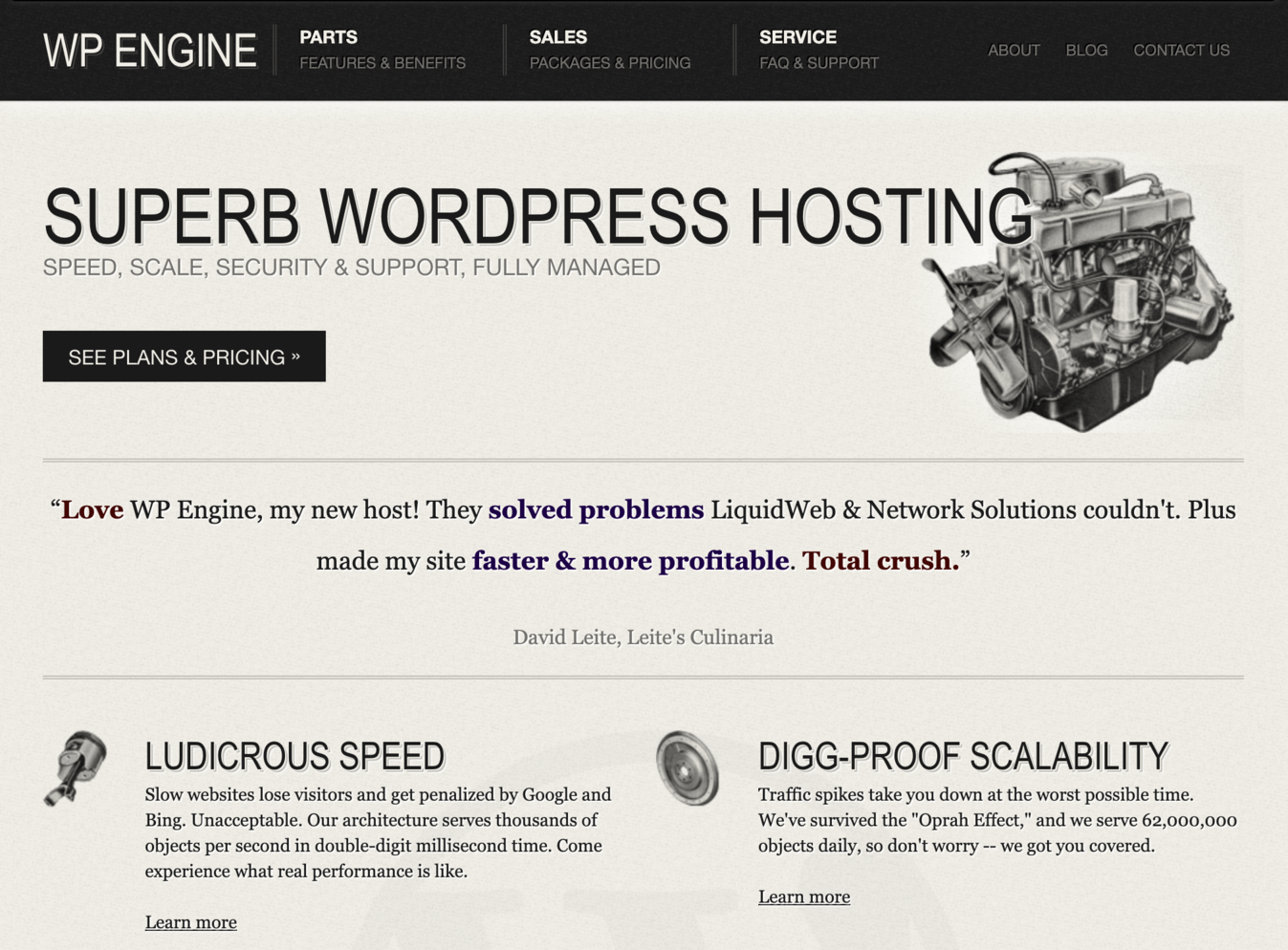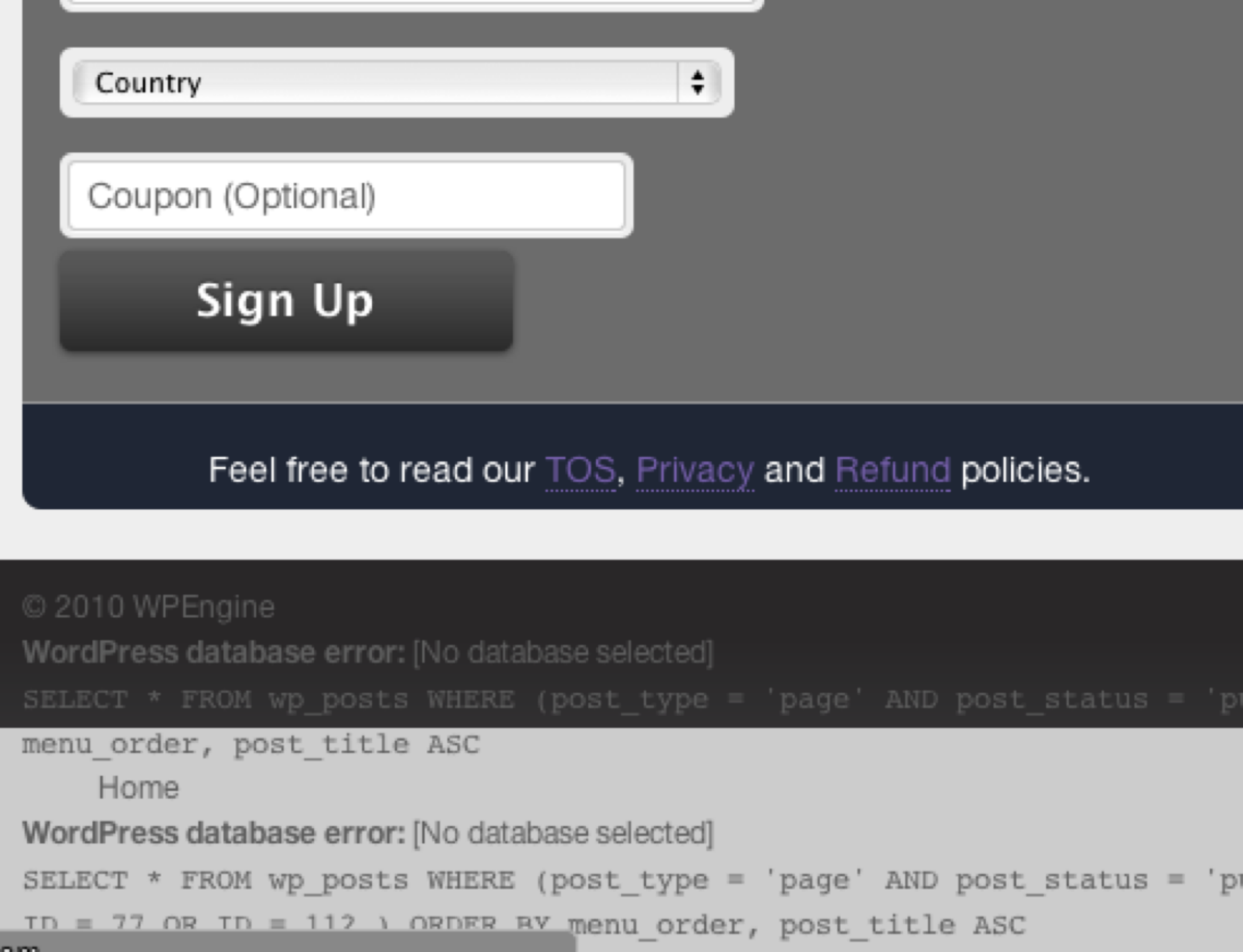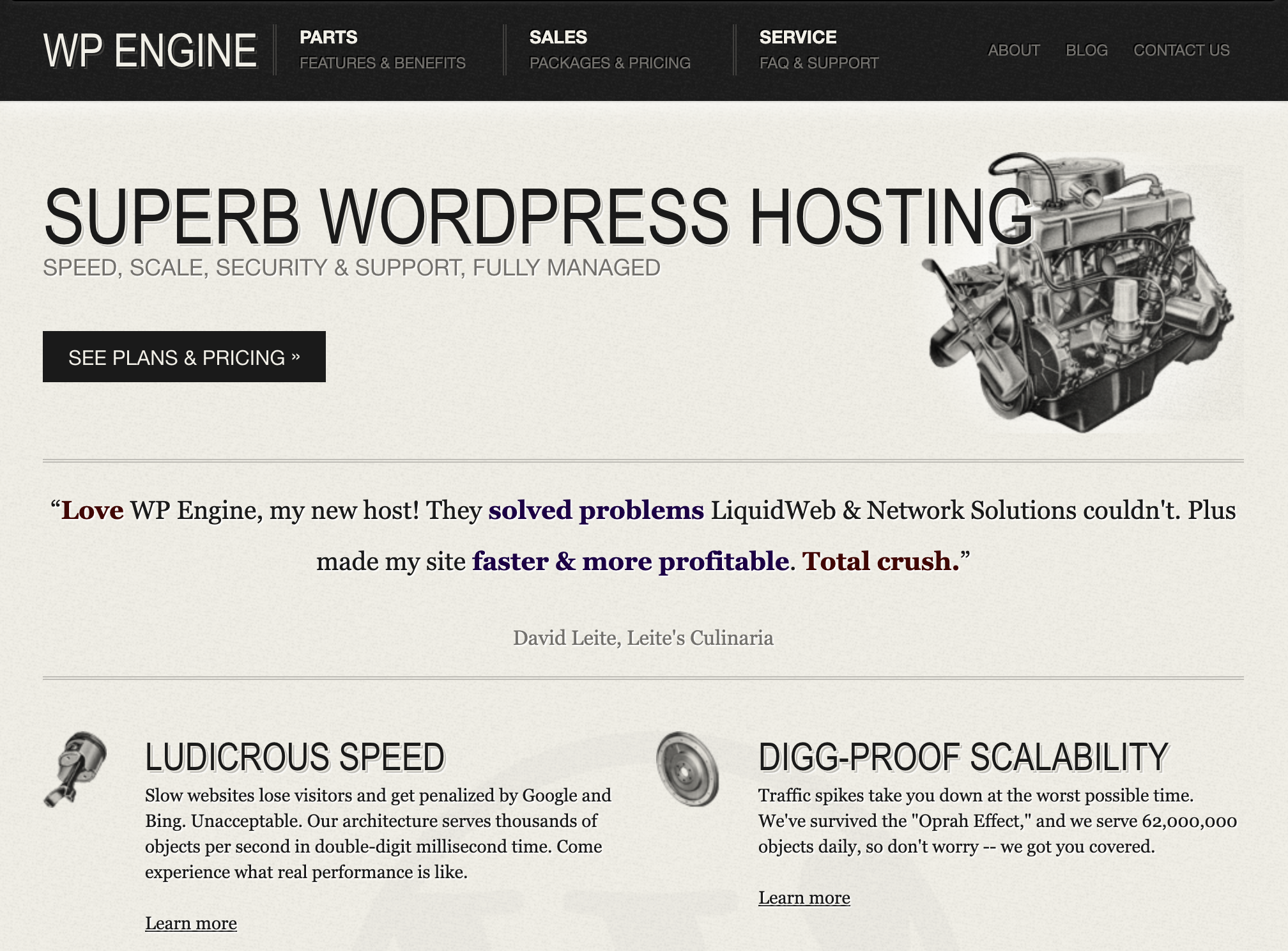On the (un?)importance of design
We recently1 underwent a Cinderella-like transformation: A total redesign of the WP Engine website from despicable steaming pile of hideousness to a designed, thematic—dare I say artistic?—sleek new look.
1 Editor’s note: This was written in 2011.
Does it matter?
It must have mattered. Look how bad it used to be. Not only were the pages ugly, they were peppered with database errors and CSS blowups:

Figure 1: Database errors shooting out the footer of the home page!
Just look at us now, sporting a grayscale 1950s automotive motif playing off the “engine” concept using the latest in CSS3/HTML5 trickery:

Figure 2: When customers have a “crush” on you, that’s not just Utility, that’s Love.
Customers emailed us saying “Thank God you fixed that horrible website. I was embarrassed when referring you to my clients.”
But hold on. They were still customers. And they still were referring us to clients. So I wondered, did it really matter?
Modern Lean Startup theory blares out from the red-tiled rooftops of Stanford: Seek the Data and Ye Shall Find!
First the bounce-rate. If our website design was repulsive—literally—the bounce rate should go down. Here’s the data:

Figure 3: Home page bounce-rate before and after website redesign
Can you see at what point in time we changed design? No? Hmm.
Let’s look at average time-on-site:

Figure 4: Average time-on-site before and after website redesign
No change.
But this is all superficial—what Really Matters is the Conversion Rate: are more or fewer people signing up each week:

Figure 5: Sales conversion rate before and after website redesign
Hmm. Looks like the data are objectively saying “design doesn’t matter.”
But as much as I respect Lean Startup theory, objective measurements aren’t the only things that matter. Those customer emails matter too.
Maybe the most interesting change was in our own team. I heard things like “I’m soooo glad we fixed the site. I was really embarrassed by it.” That matters.
The other day we landed a large customer who said they could tell from our website that among our competitors we’re more mature and ready to handle a bigger customer like them. I can tell you—objectively—that we were not particularly mature, and although I have a list of reasons why “we’re better,” the truth is that particular customer would probably also be on fine on a competitor. Was it the design that gave us that edge? Could be. Didn’t hurt, anyway.
Still, the more I look at the importance of design in the startups in my little career, the less it seems to matter. I’ve chronicled the eye-melting design that punished potential customers in the evolution of the Smart Bear website, and yet with all that cringe-worthiness, that was a company that doubled in revenue and profit every year like clockwork for half a decade—a stat any startup would be proud to match. This doesn’t prove design doesn’t matter, but it does suggest design may not be the deciding factor.
An even more extreme example comes from my second company ITWatchDogs. I displayed its old homepage at the magnificent Webstock design conference in Wellington earlier this year; the crowd whooped at our violent assault on the visual arts, complete with calliope menubar colors, two broken images tag above the fold, and a layout model that could be seen as a “grid” only after consuming a pillowcase of mushrooms:

Figure 6
But you’re anticipating the punch-line—ITWatchDogs grew every month, made millions of dollars, stole business from competitors with billion-dollar market caps (and professional-looking websites), and had a successful exit.
Of course it’s only fair to also point out some of the many instructive counter-examples:
- Hipmunk (defunct) is the same thing as Orbitz or Travelocity—the only difference is amazing design, not just because it looks good but because it’s so usable. In the words of Joel Spoksly—the design “affords usability.” (P.S. Early Hipmunk team member Alexis Ohanian is so cool and smart and rich and funny and successful and good-looking that really he doesn’t deserve to be alive. (P.P.S. Hey flamers, for God’s sake it’s a joke! Don’t you realize I’m just sore from losing the Pecha Kucha competition to him?))
- I always use and recommend Amy Hoy’s time zone tool only because it’s just nice to use and look at. (P.S. she also authors a terrific blog aimed at the solo entrepreneur.)
- Many people credit Mint’s smash success with their terrific design. Considering how many features were broken for how long, it’s hard to argue.
- 37signals documented— with data—how design changes results directly in more credit-card-swiping customers. It doesn’t get more “business value” than that.
So where does that leave us in the “matters / doesn’t matter” question of design?
Editor’s Note: In 2025, fourteen years after this article was written, the Consumerization of the Enterprise and Product-Led Growth motions has brought design to the fore in business software, and consumers have shown a willingness to pick products based on design, and even pay more for great design. It’s no longer clear that one can still hold the position that “design doesn’t matter.”
I think you can go either way, but you must decide whether or not you’re going to value design as core to your startup’s identity, and then act consistently.
It’s clear from the outset that design is the only competitive advantage Hipmunk has over its competition. Specifically, by making the flight-search problem pleasurable and usable instead of feeling like you’re navigating pivot tables from Excel ‘98. They don’t have better data, better branding, better name, better SEO, or more money. Just better design, and not just easily-copyable incremental improvement, but a quantum leap better.
When design is fundamental to the strategy—how you win, how you acquire and retain customers, garner attention and referrals, and be distinguished in the market—then design can be the most important thing.
Conversely, at ITWatchDogs the company’s internal and external culture was that “we’re low-cost, friendly, approachable, regular people, who understand exactly what you worry about, exactly what your budget is, and we nail it.” The site might have looked bad, but our message couldn’t have been clearer.

All our competitors had these slick, corporate-looking sites, whereas the indifferent chaos of our website was not unlike our customers’ offices which themselves were littered with assorted hardware corpses and solder stains. (And I don’t buy the typical retort that “that’s design too,” because no designer on Earth would have created that website because it looks “relatable.”)
Neither is it an absolute either-or whether design is important; WP Engine is a good example of this. We did fine before the redesign and we’re doing fine after it; I’m glad we did it, if not for objective data, then for the subjective feelings.
But it is useful to decide where you come down on the question of design in your startup, because if it’s important you’d better work on that right now and develop a consistent culture of valuing design through-and-through. Or if design is not important to you, you’d better decide what is important and nail those things all the harder, because you’ll be competing with people who are using superior design to cover up their lack of competency in those areas. Your superiority must shine through regardless.
https://longform.asmartbear.com/design/
© 2007-2026 Jason Cohen
 @asmartbear
@asmartbear ePub (Kindle)
ePub (Kindle)
 Printable PDF
Printable PDF












